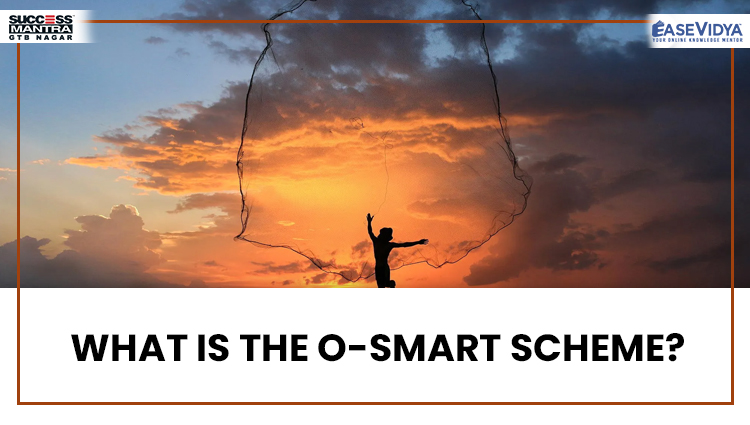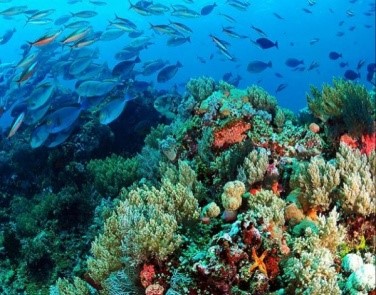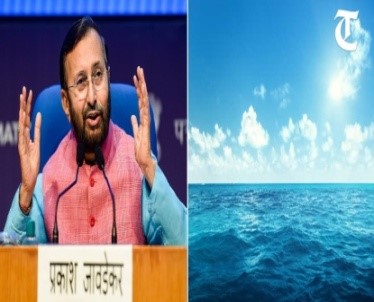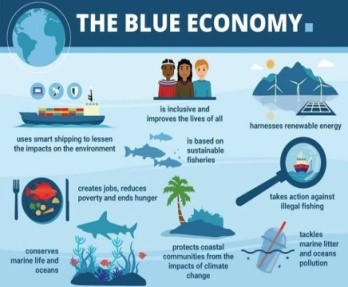
WHAT IS THE O-SMART SCHEME?
WHAT IS THE O-SMART SCHEME?
The Cabinet Committee on Economic Affairs chaired by Prime Minister Narendra Modi approved for continuing the umbrella scheme ‘Ocean Services, Modelling, Application, Resources and Technology (O-SMART)’ of the Ministry of Earth Sciences during 2021-26 at a cost of Rs 2,177 crores. The O-SMART scheme comprises seven sub-schemes which are being implemented by autonomous institutes of the Earth Sciences Ministry. A fleet of oceanographic and coast research vessels have been provided by the Earth Sciences Ministry to aid research under the O-SMART scheme.

Approval for continuing O-SMART scheme: Significance
The continuation of the Ocean Services, Modelling, Application, Resources and Technology (O-SMART) scheme during 2021-26 will augment the capacity building of India in the oceanographic field at the international level with the ongoing extensive research and technology development activities. The continuation of the O-SMART scheme will aid in strengthening India’s contribution towards a national policy on Blue Economy for efficient and effective use of the ocean resources in a sustainable way. As a multidisciplinary continuing scheme, the O-SMART scheme will offer further comprehensive coverage while strengthening ongoing activities to deliver cutting-edge technology for the marine sector, forecast and warning services, understanding marine biodiversity, coastal processes, and conservation strategies for marine living organisms. The United Nations (UN) has declared the current decade as the Decade of Ocean Science for Sustainable Development. The coastal research and marine biodiversity activities under the O-SMART scheme will help in achieving UN Sustainable Development Goal (SDG) 14 to conserve and sustainably use the oceans, seas, and marine resources. Through the ocean advisory services and technologies developed under the O-SMART scheme, several communities and sectors in the marine environment particularly the coastal states in India which in turn registers a significant contribution to the Gross Domestic Product (GDP) of India.
Current Affairs Notes By Success Mantra Coaching Institute GTB Nagar Delhi CLICK HERE
WHAT IS THE O-SMART SCHEME?
The Ocean Services, Modelling, Application, Resources and Technology (O-SMART) is a government scheme that aims at promoting ocean research and setting up early warning weather systems. The scheme also aims at addressing ocean development activities such as technology, services, resources, science, and observations as well as offering required technological assistance for implementing aspects of the Blue Economy.
Who launched the O-SMART scheme?
The O-SMART scheme was approved by the Cabinet Committee chaired by PM Narendra Modi on August 29, 2018. The Ministry of Earth Sciences works on the implementation of the scheme. The O-SMART scheme comprising oceanographic activities aims at providing forecasts and services based on the continuous observation of oceans, development of technologies, exploratory surveys for the sustainable harnessing of our oceanic resources (both non-living and living), and promotion of front-ranking research in ocean sciences.

O-SMART: Seven sub-schemes
- Ocean Technology
- Ocean Modelling and Advisory Services (OSMAS)
- Ocean Observation Network (OON)
- Ocean Non-Living Resources
- Marine Living Resources and Ecology (MLRE)
- Coastal Research and Operation
- Maintenance of Research Vessels
The scheme has enabled India to take a leadership role in implementing the Indian Ocean component of the Global Ocean Observing System in UNESCO’s Intergovernmental Oceanographic Commission (IOC). The Indian Ocean Observing System under the Global Ocean Observing System offers ocean forecast services for potential natural coastal and fishing ground hazards warnings about storms, cyclones, Tsunamis at national levels as well as neighboring countries. A state-of-the-art Early Warning System for oceanic disasters such as storms, tsunamis, has also been set up at INCOIS, Hyderabad. The system is recognized by UNESCO. The scheme aids in an extensive survey of the Indian Exclusive Economic Zone (EEZ) and the continental shelf of the Indian Ocean to identify ocean resources, navigation, ocean-related services, etc. The scheme also aids in assessing living resources in the EEZ and deep ocean, mapping marine ecosystems for conservation and protection of marine biodiversity.
UNION CABINET APPROVED 'DEEP OCEAN MISSION'
Recently, the Cabinet Committee on Economic Affairs has approved the proposal of the Ministry of Earth Sciences (MoES) on the Deep Ocean Mission (DOM). The blueprint of the DOM to explore the deep recesses of the ocean was unveiled in 2018. Earlier, MoES had also rolled out the draft Blue Economy Policy.
ABOUT THE MISSION
The cost of the Mission has been estimated at Rs. 4,077 crore over a five-year period and will be implemented in phases. MoES will be the nodal ministry implementing this multi-institutional ambitious mission. It will be a mission mode project to support the Blue Economy Initiatives of the Government of India. Blue Economy is the sustainable use of ocean resources for economic growth, improved livelihoods and jobs, and ocean ecosystem health. The technology and expertise needed in such missions is now available with only five countries - US, Russia, France, Japan and China. India will now be the sixth country to have it.
MAJOR COMPONENTS OF THE INITIATIVE
- Development of Technologies for Deep Sea Mining, and Manned Submersible: A manned submersible will be developed to carry three people to a depth of 6,000 metres in the ocean with a suite of scientific sensors and tools. An Integrated Mining System will be also developed for mining polymetallic nodules at those depths in the central Indian Ocean. Polymetallic nodules are rocks scattered on the seabed containing iron, manganese, nickel and cobalt. The exploration studies of minerals will pave the way for commercial exploitation in the near future, as and when commercial exploitation code is evolved by the International Seabed Authority, an United Nations (UN) organisation.
- Development of Ocean Climate Change Advisory Services: It entails developing a suite of observations and models to understand and provide future projections of important climate variables on seasonal to decadal time scales.
- Technological Innovations for Exploration and Conservation of Deep-sea Biodiversity: Bio-prospecting of deep sea flora and fauna including microbes and studies on sustainable utilization of deep sea bio-resources will be the main focus.
- Deep Ocean Survey and Exploration: It will explore and identify potential sites of multi-metal Hydrothermal Sulphides mineralization along the Indian Ocean mid-oceanic ridges.
- Energy and Freshwater from the Ocean: Studies and detailed engineering design for offshore Ocean Thermal Energy Conversion (OTEC) powered desalination plants are envisaged in this proof of concept proposal. OTEC is a technology which uses ocean temperature differences from the surface to depths lower than 1,000 meters, to extract energy.
- Advanced Marine Station for Ocean Biology: It is aimed at the development of human capacity and enterprise in ocean biology and engineering. It will translate research into industrial application and product development through on-site business incubator facilities.
OTHER BLUE ECONOMY INITIATIVES
- India-Norway Task Force on Blue Economy for Sustainable Development : It was inaugurated jointly by both the countries in 2020 to develop and follow up joint initiatives between the two countries.
- Sagarmala Project: The Sagarmala project is the strategic initiative for port-led development through the extensive use of IT enabled services for modernization of ports.
- O-SMART: India has an umbrella scheme by the name of O-SMART which aims at regulated use of oceans, marine resources for sustainable development.
- Integrated Coastal Zone Management: It focuses on conservation of coastal and marine resources, and improving livelihood opportunities for coastal communities etc.
- National Fisheries Policy: India has a National Fisheries policy for promoting 'Blue Growth Initiative' which focuses on sustainable utilization of fisheries wealth from marine and other aquatic resources.
WHAT IS BLUE ECONOMY?
The concept was introduced by Gunter Pauli in his 2010 book- “The Blue Economy: 10 years, 100 innovations, 100 million jobs”. It is the sustainable use of ocean resources for economic growth, improved livelihoods and jobs, and ocean ecosystem health. It advocates the greening of ocean development strategies for higher productivity and conservation of ocean's health.
- It encompasses– Renewable Energy: Sustainable marine energy can play a vital role in social and economic development.
- Fisheries: Sustainable fisheries can generate more revenue, more fish and help restore fish stocks.
- Maritime Transport: Over 80% of international goods traded are transported by sea.
- Tourism: Ocean and coastal tourism can bring jobs and economic growth.
- Climate Change: Oceans are an important carbon sink (blue carbon) and help mitigate climate change.
- Waste Management: Better waste management on land can help oceans recover. Blue Economy emphasizes on integration of development of the ocean economy with social inclusion, environmental sustainability, combined with innovative business models.

PRAVAHINI Current Affairs Notes By Success Mantra Coaching Institute GTB Nagar Delhi CLICK HERE
TEST YOURSELF
Q.1 Which of the following ministries implements the O-SMART scheme which was approved by the Cabinet Committee chaired by PM Narendra Modi on August 29, 2018?
- Ganga Rejuvenation Ministry
- Ministry of Jal Shakti
- Ministry of Earth Sciences: ANSWER
- None of the following
Q.2 Consider the given statements & state which of the following is correct in the reference to the above mentioned passage?
- The United Nations (UN) has declared the decade of 2031-2040 as the Decade of Ocean Science for Sustainable Development.
- The coastal research and marine biodiversity activities under the O-SMART scheme will help in achieving UN Sustainable Development Goal (SDG) 14 to conserve and sustainably use the oceans, seas, and marine resources.
- Only I follows
- Only II follows: ANSWER
- Both I & II follows
- None of the following
Q.3 The Cabinet Committee on Economic Affairs has approved which of the following Ministries' proposals on the Deep Ocean Mission (DOM)?
- Ministry of Water Resources & River Development
- Ministry of Earth Sciences: ANSWER
- Ministry of Jal Shakti
- None of the following
Q.4 Which of the following given statements is/are correct in the reference to the Deep Ocean Mission of the Central Government?
- The cost of the Mission has been estimated at Rs. 4,077 crore over a five-year period and will be implemented in phases
- It will be a mission mode project to support the Blue Economy Initiatives of the Government of India.
- The technology and expertise needed in such missions is now available with only four countries - US, Germany, France & United Kingdom. India will now be the fifth country to have it.
- II & III follows
- Only I follows
- I, II & III follows
- None of the above: ANSWER
Q.5 Which of the following is an umbrella scheme of India which aims at regulated use of oceans, marine resources for sustainable development?
- Sagarmala Project
- O-SMART scheme: ANSWER
- STARS Project
- All of the above













gsjobvvbdh
WHAT IS THE O-SMART SCHEME? | Read Daily Article Editorials Only On Success Mantra Blog | Daily Article | Monthly Article | Weekly Article | Yearly Article | Most Requesting Articles | Legal Awareness Articles | Current Affairs | Passage Based Current Affairs | One Linear Current Affairs | Current Affairs For CLAT | Current Affairs For AILET | Current Affairs For Slat | Legal Aptitude Current Affairs | Law Current Affairs | Current Event | Current Affairs Pdf | Current Affairs Pdf In English | Current Affairs Pdf Free Download | Current Affairs MCQ | Current Affairs MCQS | Current Affairs Work Sheet | Current Affairs UPSC | Current Affairs BBA | Current Affairs BCA | Current Affairs BJMC | Current Affairs NCHMJEE | Daily Editorial | Monthly Editorial | Weekly Editorial | Yearly Editorial | Most Asking Editorials | Legal Awareness Editorials | Current Editorial | Passage Based Current Editorial | One Linear Current Editorial | Current Editorial For CLAT | Current Editorial For AILET | Current Editorial For Slat | Legal Aptitude Current Editorial | Law Current Editorial | Current Event | Current Editorial Pdf | Current Editorial Pdf In ENGLISH | Current Editorial Pdf Free Download | Current Editorial MCQ | Current Editorial MCQS | Current Editorial Work Sheet | Current Editorial UPSC | Current Editorial BBA | Current Editorial BCA | Current Editorial BJMC | Current Editorial NCHMJEE | Latest News In India | Latest News In Hindi | Latest News Delhi | Latest News Today India | Latest News Live | 3 Latest News | Latest News Today Delhi | Latest News Aajtak | News Articles India | News Articles For Students | News Articles 2020 | News Articles In English | News Articles In Hindi | News Article Example | Short News Articles | News Article Meaning | Success Mantra Delhi | CLAT Coaching In Delhi | Best CLAT Du LLB Institute In Delhi | Read Daily Article Editorials Only On Success Mantra Blog [url=http://www.gg889fmlr2wf033e0spew74y7h32r377s.org/]ugsjobvvbdh[/url] <a href="http://www.gg889fmlr2wf033e0spew74y7h32r377s.org/">agsjobvvbdh</a> gsjobvvbdh http://www.gg889fmlr2wf033e0spew74y7h32r377s.org/
ymsxhzzobw
WHAT IS THE O-SMART SCHEME? | Read Daily Article Editorials Only On Success Mantra Blog | Daily Article | Monthly Article | Weekly Article | Yearly Article | Most Requesting Articles | Legal Awareness Articles | Current Affairs | Passage Based Current Affairs | One Linear Current Affairs | Current Affairs For CLAT | Current Affairs For AILET | Current Affairs For Slat | Legal Aptitude Current Affairs | Law Current Affairs | Current Event | Current Affairs Pdf | Current Affairs Pdf In English | Current Affairs Pdf Free Download | Current Affairs MCQ | Current Affairs MCQS | Current Affairs Work Sheet | Current Affairs UPSC | Current Affairs BBA | Current Affairs BCA | Current Affairs BJMC | Current Affairs NCHMJEE | Daily Editorial | Monthly Editorial | Weekly Editorial | Yearly Editorial | Most Asking Editorials | Legal Awareness Editorials | Current Editorial | Passage Based Current Editorial | One Linear Current Editorial | Current Editorial For CLAT | Current Editorial For AILET | Current Editorial For Slat | Legal Aptitude Current Editorial | Law Current Editorial | Current Event | Current Editorial Pdf | Current Editorial Pdf In ENGLISH | Current Editorial Pdf Free Download | Current Editorial MCQ | Current Editorial MCQS | Current Editorial Work Sheet | Current Editorial UPSC | Current Editorial BBA | Current Editorial BCA | Current Editorial BJMC | Current Editorial NCHMJEE | Latest News In India | Latest News In Hindi | Latest News Delhi | Latest News Today India | Latest News Live | 3 Latest News | Latest News Today Delhi | Latest News Aajtak | News Articles India | News Articles For Students | News Articles 2020 | News Articles In English | News Articles In Hindi | News Article Example | Short News Articles | News Article Meaning | Success Mantra Delhi | CLAT Coaching In Delhi | Best CLAT Du LLB Institute In Delhi | Read Daily Article Editorials Only On Success Mantra Blog [url=http://www.g5l13n9ix61z160vt9gns7a0vh836k0ts.org/]uymsxhzzobw[/url] ymsxhzzobw http://www.g5l13n9ix61z160vt9gns7a0vh836k0ts.org/ <a href="http://www.g5l13n9ix61z160vt9gns7a0vh836k0ts.org/">aymsxhzzobw</a>
cmlobvxqp
WHAT IS THE O-SMART SCHEME? | Read Daily Article Editorials Only On Success Mantra Blog | Daily Article | Monthly Article | Weekly Article | Yearly Article | Most Requesting Articles | Legal Awareness Articles | Current Affairs | Passage Based Current Affairs | One Linear Current Affairs | Current Affairs For CLAT | Current Affairs For AILET | Current Affairs For Slat | Legal Aptitude Current Affairs | Law Current Affairs | Current Event | Current Affairs Pdf | Current Affairs Pdf In English | Current Affairs Pdf Free Download | Current Affairs MCQ | Current Affairs MCQS | Current Affairs Work Sheet | Current Affairs UPSC | Current Affairs BBA | Current Affairs BCA | Current Affairs BJMC | Current Affairs NCHMJEE | Daily Editorial | Monthly Editorial | Weekly Editorial | Yearly Editorial | Most Asking Editorials | Legal Awareness Editorials | Current Editorial | Passage Based Current Editorial | One Linear Current Editorial | Current Editorial For CLAT | Current Editorial For AILET | Current Editorial For Slat | Legal Aptitude Current Editorial | Law Current Editorial | Current Event | Current Editorial Pdf | Current Editorial Pdf In ENGLISH | Current Editorial Pdf Free Download | Current Editorial MCQ | Current Editorial MCQS | Current Editorial Work Sheet | Current Editorial UPSC | Current Editorial BBA | Current Editorial BCA | Current Editorial BJMC | Current Editorial NCHMJEE | Latest News In India | Latest News In Hindi | Latest News Delhi | Latest News Today India | Latest News Live | 3 Latest News | Latest News Today Delhi | Latest News Aajtak | News Articles India | News Articles For Students | News Articles 2020 | News Articles In English | News Articles In Hindi | News Article Example | Short News Articles | News Article Meaning | Success Mantra Delhi | CLAT Coaching In Delhi | Best CLAT Du LLB Institute In Delhi | Read Daily Article Editorials Only On Success Mantra Blog [url=http://www.g7rhfl0587li31kr73p26q62ic02ogd6s.org/]ucmlobvxqp[/url] <a href="http://www.g7rhfl0587li31kr73p26q62ic02ogd6s.org/">acmlobvxqp</a> cmlobvxqp http://www.g7rhfl0587li31kr73p26q62ic02ogd6s.org/
ghsofqsei
WHAT IS THE O-SMART SCHEME? | Read Daily Article Editorials Only On Success Mantra Blog | Daily Article | Monthly Article | Weekly Article | Yearly Article | Most Requesting Articles | Legal Awareness Articles | Current Affairs | Passage Based Current Affairs | One Linear Current Affairs | Current Affairs For CLAT | Current Affairs For AILET | Current Affairs For Slat | Legal Aptitude Current Affairs | Law Current Affairs | Current Event | Current Affairs Pdf | Current Affairs Pdf In English | Current Affairs Pdf Free Download | Current Affairs MCQ | Current Affairs MCQS | Current Affairs Work Sheet | Current Affairs UPSC | Current Affairs BBA | Current Affairs BCA | Current Affairs BJMC | Current Affairs NCHMJEE | Daily Editorial | Monthly Editorial | Weekly Editorial | Yearly Editorial | Most Asking Editorials | Legal Awareness Editorials | Current Editorial | Passage Based Current Editorial | One Linear Current Editorial | Current Editorial For CLAT | Current Editorial For AILET | Current Editorial For Slat | Legal Aptitude Current Editorial | Law Current Editorial | Current Event | Current Editorial Pdf | Current Editorial Pdf In ENGLISH | Current Editorial Pdf Free Download | Current Editorial MCQ | Current Editorial MCQS | Current Editorial Work Sheet | Current Editorial UPSC | Current Editorial BBA | Current Editorial BCA | Current Editorial BJMC | Current Editorial NCHMJEE | Latest News In India | Latest News In Hindi | Latest News Delhi | Latest News Today India | Latest News Live | 3 Latest News | Latest News Today Delhi | Latest News Aajtak | News Articles India | News Articles For Students | News Articles 2020 | News Articles In English | News Articles In Hindi | News Article Example | Short News Articles | News Article Meaning | Success Mantra Delhi | CLAT Coaching In Delhi | Best CLAT Du LLB Institute In Delhi | Read Daily Article Editorials Only On Success Mantra Blog <a href="http://www.gj49n7ui6jnmyex7r06ps6725jg43030s.org/">aghsofqsei</a> [url=http://www.gj49n7ui6jnmyex7r06ps6725jg43030s.org/]ughsofqsei[/url] ghsofqsei http://www.gj49n7ui6jnmyex7r06ps6725jg43030s.org/
yemmbxioox
WHAT IS THE O-SMART SCHEME? | Read Daily Article Editorials Only On Success Mantra Blog | Daily Article | Monthly Article | Weekly Article | Yearly Article | Most Requesting Articles | Legal Awareness Articles | Current Affairs | Passage Based Current Affairs | One Linear Current Affairs | Current Affairs For CLAT | Current Affairs For AILET | Current Affairs For Slat | Legal Aptitude Current Affairs | Law Current Affairs | Current Event | Current Affairs Pdf | Current Affairs Pdf In English | Current Affairs Pdf Free Download | Current Affairs MCQ | Current Affairs MCQS | Current Affairs Work Sheet | Current Affairs UPSC | Current Affairs BBA | Current Affairs BCA | Current Affairs BJMC | Current Affairs NCHMJEE | Daily Editorial | Monthly Editorial | Weekly Editorial | Yearly Editorial | Most Asking Editorials | Legal Awareness Editorials | Current Editorial | Passage Based Current Editorial | One Linear Current Editorial | Current Editorial For CLAT | Current Editorial For AILET | Current Editorial For Slat | Legal Aptitude Current Editorial | Law Current Editorial | Current Event | Current Editorial Pdf | Current Editorial Pdf In ENGLISH | Current Editorial Pdf Free Download | Current Editorial MCQ | Current Editorial MCQS | Current Editorial Work Sheet | Current Editorial UPSC | Current Editorial BBA | Current Editorial BCA | Current Editorial BJMC | Current Editorial NCHMJEE | Latest News In India | Latest News In Hindi | Latest News Delhi | Latest News Today India | Latest News Live | 3 Latest News | Latest News Today Delhi | Latest News Aajtak | News Articles India | News Articles For Students | News Articles 2020 | News Articles In English | News Articles In Hindi | News Article Example | Short News Articles | News Article Meaning | Success Mantra Delhi | CLAT Coaching In Delhi | Best CLAT Du LLB Institute In Delhi | Read Daily Article Editorials Only On Success Mantra Blog yemmbxioox http://www.gcj77c9q61z0s8855j3bi38wq93x9xdls.org/ [url=http://www.gcj77c9q61z0s8855j3bi38wq93x9xdls.org/]uyemmbxioox[/url] <a href="http://www.gcj77c9q61z0s8855j3bi38wq93x9xdls.org/">ayemmbxioox</a>
djdpgqoog
Latest News on Education & LAW Exams Blogs | Success Mantra djdpgqoog http://www.gvrfx69981gny9i3a97mf5p653jdi875s.org/ <a href="http://www.gvrfx69981gny9i3a97mf5p653jdi875s.org/">adjdpgqoog</a> [url=http://www.gvrfx69981gny9i3a97mf5p653jdi875s.org/]udjdpgqoog[/url]
nwywifvjtw
Latest News on Education & LAW Exams Blogs | Success Mantra [url=http://www.g79aib4yo6d45uw1s014e3a9gosn1843s.org/]unwywifvjtw[/url] <a href="http://www.g79aib4yo6d45uw1s014e3a9gosn1843s.org/">anwywifvjtw</a> nwywifvjtw http://www.g79aib4yo6d45uw1s014e3a9gosn1843s.org/
ydnvyjwcwr
Latest News on Education & LAW Exams Blogs | Success Mantra <a href="http://www.g917cm3i03trd61mr21tic194ek9q29ms.org/">aydnvyjwcwr</a> ydnvyjwcwr http://www.g917cm3i03trd61mr21tic194ek9q29ms.org/ [url=http://www.g917cm3i03trd61mr21tic194ek9q29ms.org/]uydnvyjwcwr[/url]
xgjtnmmjg
Latest News on Education & LAW Exams Blogs | Success Mantra <a href="http://www.gkjr020jvo91o2p5fqn5c794h4d6x697s.org/">axgjtnmmjg</a> [url=http://www.gkjr020jvo91o2p5fqn5c794h4d6x697s.org/]uxgjtnmmjg[/url] xgjtnmmjg http://www.gkjr020jvo91o2p5fqn5c794h4d6x697s.org/
zedodzlm
Latest News on Education & LAW Exams Blogs | Success Mantra <a href="http://www.ga7u26083cdwczf7u81813y747l7iqfls.org/">azedodzlm</a> [url=http://www.ga7u26083cdwczf7u81813y747l7iqfls.org/]uzedodzlm[/url] zedodzlm http://www.ga7u26083cdwczf7u81813y747l7iqfls.org/
hpwtceesl
Latest News on Education & LAW Exams Blogs | Success Mantra [url=http://www.ge3334na34azih780b17q3lrbj9rx190s.org/]uhpwtceesl[/url] hpwtceesl http://www.ge3334na34azih780b17q3lrbj9rx190s.org/ <a href="http://www.ge3334na34azih780b17q3lrbj9rx190s.org/">ahpwtceesl</a>